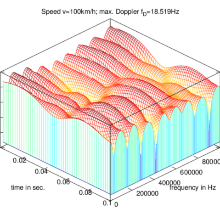Synopsis
Wireless communications is today's predominant network access technology, be it Bluetooth, WiFi, or Mobile Cellular Systems such as GSM, UMTS, LTE or 5G. Coding and signal processing for wireless communications allows to seamlessly connect devices to computers as cable replacement, to connect people across cities and counties, and to communicate to distant space probes. This course introduces physical layer technologies and modulation as well as detection schemes to communicate reliably at different data rates, different distances and rapidly changing channel conditions determined by the involved vehicle speeds and multipath propagation characteristics.
Contents and Educational Objectives
Lecture 1: Wireless Channel: Path Loss and Statistical Characterization
1.1. Path loss: Describing Long-Term Channel Variations
Free-space path loss, "Breakpoint" path loss model (two-path model)
1.2. Statistical Characterization of Channel Variations
Large-scale channel variations: Shadow fading, Large-scale fading margin
1.A. Appendix
Okumura-Hata model, Motley-Keenan indoor path loss model
Smallscale channel variations: Rayleigh fading, Small-scale fading margin
Combined fading margin
Lecture 2: Link Budget and Receiver Sensitivity
2.1. Thermal Noise Power
2.2. Receiver Sensitivity and Signal-to-Noise Ratio
2.3. Link Budget: An End-to-End View
2.A. Appendix
Interference in unlicensed ISM band, Symbol and bit-error probabilities of some modulation schemes
Lecture 3: Stochastic Channel Models: Time and Frequency-Selective Fading
3.1. Frequency-selective fading
Tapped-delay line model of multipath propagation, Delay spread and coherence bandwidth
Mitigating multipath: From single to multi-carrier
3.2. Time-selective fading
Doppler spread and coherence time, Superposition of two paths with opposite Doppler shifts
Jakes/Clarke model: Superposition of many paths
3.3. Putting both together: General wideband channels
Examples of different systems, Concluding remarks
3.A. Appendix
Real-world example: The WLAN802.11a-indoor channel model
Generation of time-selective fading using the Jakes/Clarke model
Lecture 4: Channel Coding, Modulation and Capacity
4.1. Channel Capacity
AWGN capacity, Rayleigh capacity, Spectral efficiency chart
Discrete-input constrained capacities (digital QAM)
Information rates, and a first trial by repetition coding
4.2. Channel coding for wireless communications
4.3. Coding and modulation in the spectral efficiency chart
4.A. Appendix
Discussion of power and bandwidth limited regime
Lecture 5: Single Carrier Modulation: Packet Structure and Preamble Processing
5.1. Transmitter and Receiver Block Diagram
5.2. Packet and Preamble Format
Brief overview of preamble processing steps, Brief overview of header and payload processing
5.3. Packet Detection by Correlation
Auto and cross-correlation of sequences, Building long preambles using short sequences
False alarm/missed detection probabilities, Frame synchronization
5.4. Automatic Gain Control
Lecture 6: Timing/Frequency Offset and Channel Estimation
6.1. Timing Offset Estimation
Effect of timing offset, Initial timing offset estimation
Timing offset tracking
6.2. Frequency Offset Estimation and Tracking
Effect of frequency offset and its compensation, Initial frequency offset estimation
Frequency offset tracking
6.3. Channel estimation
Initial channel estimation and compensation, Channel interpolation and tracking
Lecture 7: Soft-Demapping of QAM Symbols
7.1. Hard decision demapping
7.2. Soft “decision” demapping
7.3. Channel L-values for BPSK
7.4. Soft-demapping of constellations with two bits
Example: 4-PAM constellation
7.5. Soft-demapping of general constellations
7.6. Quantifying performance gains of soft-demapping
7.A. Appendix
Another 2-bit constellation example: QPSK, Iterative receiver processing
Editorial notes
Lecture 8: Linear Equalization of Multipath Channels
8.1. Basic equalization schemes
8.2. Ideal (zero forcing) equalization
8.3. Truncated Zero-Forcing (ZF) equalization
Equalizer coefficients from Taylor series expansion
Equalizer coefficients from system of linear equations
8.4. Least Squares and Minimum Mean Squared Error
8.5. Performance comparison in the BER chart
Lecture 9: Nonlinear (Viterbi-)Equalization
9.1. Simplifying the likelihood function for the AWGN channel
9.2. Multipath channel as shift register
9.3. The Viterbi Algorithm
9.4. Example of the Viterbi Algorithm
9.A. Appendix
Lecture 10: Multicarrier Modulation (OFDM)
10.1. From single to multi-carrier modulation
10.2. Performance over multipath channels
10.3. Cyclic prefix (guard interval)
10.4. Description in discrete-time
Lecture 11: OFDM Transmitter Aspects: PAPR and Spectral Shaping
11.1. Transmit Chain
11.2. Peak-to-Average Power Ratio (PAPR)
Distribution of amplitude and power variations
Rapp’s amplifier model, output power back-off (OBO)
11.3. Spectral Shaping
Tone nulling and frequency notches, Frequency domain pre-emphasis
11.A. Appendix
Single Frequency Networks for Broadcast
Lecture 12: OFDM Receiver Aspects: Frequency Offset and Channel Estimation
12.1. Receive Chain
Guard interval removal
12.2. Frequency Offset Estimation and Compensation
12.3. Channel Estimation
Pilot Patterns, 2D-LMMSE/Wiener filter based
Lecture 13: Multiple Antenna Communications: Open Loop
13.1. Receive Antenna Diversity for Reliability Improvement
Maximum ratio combining (MRC), Selection combining
13.2. SystemModel of Open Loop MIMO
13.3. Capacity of MIMO Channels
13.4. Spatial Multiplex for Data Rate Increase
Linear front-ends, Successive cancellation
Maximum likelihood and APP detection, Sphere decoding
MIMO Detection performance
Lecture 14: Multiple Antenna Communications: Closed Loop
14.1. Channel Estimation in MIMO Systems
14.2. Preliminaries: Steering Antenna Beams
14.3. Closed Loop MIMO with Full Channel Feedback
14.4. Point-to-point, LoS: Beamforming
14.5. Point-to-Multipoint, (N)LoS: Multiuser/Massive MIMO
Note: Course contents subject to change in order to keep up-to-date with latest research results and developments in the communications industry.
Course Information
6 ECTS Credits
Lectures
| Lecturer | Prof. Dr.-Ing. Stephan ten Brink |
| Time Slot | Thursday, 8:00-9:30 |
| Lecture Hall | V47/02/2.314 |
| Weekly Credit Hours | 2 |
Exercises
| Lecturer | Florian Euchner, Felix Krieg and Maximilian Bauhofer |
| Time Slot | Friday, 8:00-9:30 |
| Lecture Hall | V47/02/2.314 |
| Weekly Credit Hours | 2 |

Stephan ten Brink
Prof. Dr.-Ing.Director


